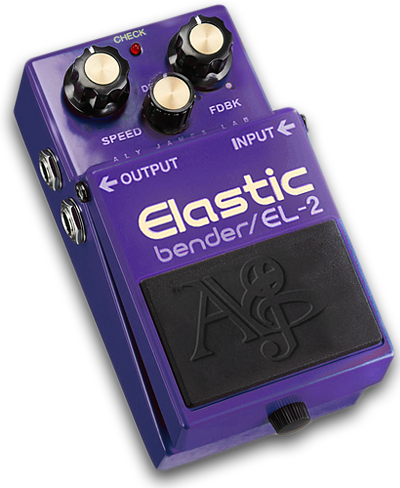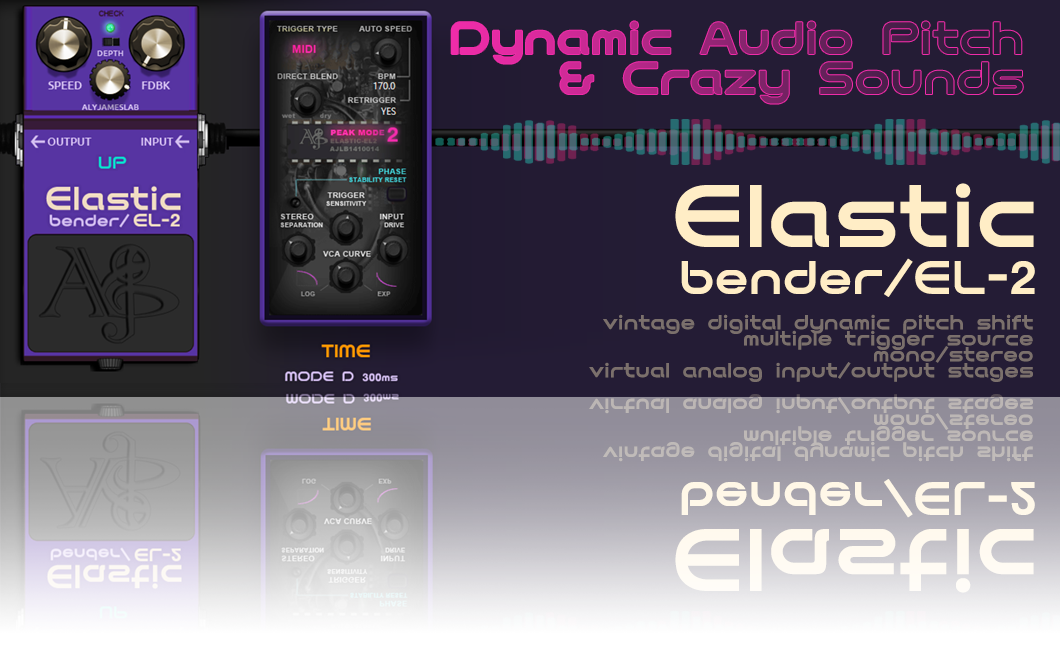WAY MORE THAN DYNAMIC AUDIO BENDING !

The ELASTIC Bender, adaptable for various sound sources, introduces a new dimension of pitch modulation. It's an innovative tool that captures the essence of dynamic envelope triggering with a nod to vintage pitch-shifting.
With the ELASTIC Bender, audio peaks initiate a customizable pitch envelope, creating dynamic bends from notes. The user can finely tune the envelope's depth, speed, and shape, achieving both subtle shifts and dramatic transformations.
Imagine a dynamic pitch shifter, or a "dynamic Whammy," that bends your notes with precision as it responds to audio peaks. With ELASTIC Bender, you command the depth, speed, and contour of the pitch envelope, ensuring each note sweeps back seamlessly to its original pitch.
This effect isn't just expressive—it's downright funky, especially with brief envelope times. But don't be fooled; the ELASTIC Bender is much more than an auto-bend tool.
Rooted in the architecture of historical pitch shifters, this effect also offers a range of modulation features. Its analog-modeled input circuitry can add harmonic richness to any input source.
Explore MODE B's capabilities for generating vibrant chorus and flange effects, or use MODE D for creating grainy reverb textures and pitch shifts. Engaging the feedback control can lead to intriguing and intense soundscapes.
ELASTIC Bender incorporates true stereo processing, enhancing spatial effects and providing a nuanced stereo field.
The internal mechanisms are just as versatile, with three envelope trigger sources: audio peaks, an integrated LFO, and MIDI notes. This flexibility allows for rhythmic synchronization and creative sequencing.

New videos will come soon, these are mostly old 2014 videos from version 1 but are still relevant
ANALOG MODELED INPUT & OUTPUT TRANSISTOR OVERDRIVE
If pushed to far the circuitry will nicely overdrive, this is noticeable also with high amount of feedback or when the pedal reach self-oscillation.
.
BEND DIRECTION
The bend can start lower before reaching the actual incoming pitch or the other way around.
Envelope time follows the SPEED setting to go from very short to very long audio bends. The incoming dry signal can be mixed with the effected one to produce chorus, flange, ring modulation or early vintage pitch shifter effects.
3 TRIGGER SOURCES
The pitch envelope can be triggered either by the detected audio peaks, the internal LFO or MIDI notes.
The internal LFO can also be re-triggered by an incoming peak if needed or can be free running. The third source available: incoming MIDI notes, is a nice way to get precise control over the bend triggers or to create precise tempo synced rhythmic patterns.
The pitch envelope shape can also be adjusted from log to exponential curve, middle point being a linear response.
FEEDBACK
ELASTIC Bender uses feedback paths to produce flanging or wild pitch shifted effects. If the feedback is set to max the pedal will start to self-oscillate, which means that even if there is no more audio coming into the effect you can still produce an analog sound and modulate it somehow. This will end as soon as you dial back the feedback amount.
TRIGGER PEAK SENSITIVITY
You will need to adjust the sensitivity to match the behavior you want based on the incoming signal, for example: only triggers when hit hard.
Basically you would add sensitivity for low level signals and reduce it for high levels.
TRUE STEREO PROCESSING & MONO 2 STEREO
You can use ELASTIC Bender as an insert on mono or stereo channels both channels will be processed independently.
If you use a mono signal such as a guitar on a stereo channel, you can use the ELASTIC Bender as an insert or as a send effect. The stereo separation feature will change the time relation between both delay lines and produce a stereo pitched output from your mono signal.
GUI & AUTOMATION
Most of ELASTIC Bender's parameters support automation and can also be MIDI learned and controlled by external MIDI Hardware, which gives you far more ways to be experimental.
(Additional technical info is into the manual.)
If used in real time, ELASTIC Bender EL-2 MODE B use only a few delay stages (10ms) and is suitable for real time playing while the MODE D uses more stages (300ms) which makes it more useful when the wet signal is blended with the dry source.
There is no similar effect that I can think of as a plugin effect, the auto bend concept is only featured in some ZOOM multi effects unit (first seen on a 9030 Pro FX Unit) and is known as the "bendchorus" it only features a short bend ability though and there are no other controls besides the speed and depth.
As a musician and also guitarist I think that an auto dynamic bend effect is very close to the expressivity given by a dynamic envelope filter pedal and that this effect should be more known and more used, a special trick of mine is to use it either as a solo send FX for Stereo Flanging craziness or to use it in dynamic pitch mode with a Wah pedal before for extreme funkiness.
Maybe I will make a hardware boutique pedal or rack at some point... :)
Windows:
Windows 7 to 10 and higher, 64bit host, plugin provided formats are VST2 and VST3.
Mac OS:
Mac OS (10.10) to Catalina/Big Sur or higher, 64bit host, plugin provided format is AU (AudioUnits).
About AudioUnits format:
AU is Apple s proprietary audio technology, part of the Core Audio provided by Mac OSX. It is part of the operating system so it provides low latency and system-level support for the interface. Most DAWs developed for Mac OSX support the Audio Units interface due to its stability and system-level solutions (which also means faster processing). Apple Logic only utilizes Audio Unit format plugins, but other DAWs such as Ableton can also use these.
One or two DAWs like for example Cubase do not support Audiounits directly yet but you can still easily load an AU plugin with the help of a VST host plugin, some popular solutions are DDMF Metaplugin or BlueCat's Patchworks, a popular free one that recently got open sourced is KUSHVIEW ELEMENT. You will find info and a direct link to latest free binaries at the support/OSX Support part of my website.
Protools:
Avid Protools only supports its proprieratary format AAX at the moment but you can still easily load an AU or VST plugin with the help of a VST/AU host plugin, some popular solutions are DDMF Metaplugin or BlueCat's Patchworks, others might be available that I am not aware of yet.
Other info:
Working fine on Mac M1 (even if not native ARM yet). Working perfectly using Apple Rosetta 2 compatibility (only needed for VST format) AU format should load fine without doing anything else. Native ARM support and Mac VST3 format are coming with next update.
For now here is a quick overview that should get you started!
ELASTIC BENDER MANUAL V2.
You can check your current version with a right click on the GUI.
Updates for Elastic Bender
VST are free until major version updates
Get ELASTIC BENDER v2 for PC & MAC
| Machine | Format(s) | Architecture(s) | Native Processor(s) | OS Supported | Note |
|---|---|---|---|---|---|
| PC | VST3 | X64 | INTEL | Windows 10 or higher | |
| Mac | AU | X64 | INTEL | Mac OS-10.10 or higher | Mac VST3 and Native Silicon in next update |
Elastic Bender comes with both PC & Mac Installers.
*works on Mac M1 even if not native ARM yet (see compatiblity info tab)